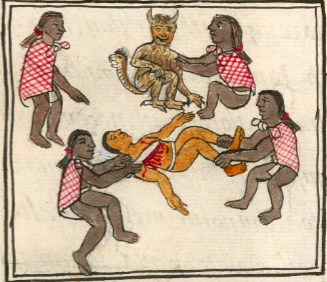ixtlilmaca (FCbk8f34v)
This iconographic example, featuring a Nahua priest wearing black face paint (ixtlilmaca) is included in this digital collection for the purpose of making potential comparisons with related hieroglyphs. The term selected for this example comes from the keywords chosen by the team behind the Digital Florentine Codex. There is no gloss. This example shows a priest in a profile view, facing right. He has long hair pulled back with a red tie at the back of his neck. The face paint ends just below his jaw line. But the contextualizing image seems to show some black paint on his legs, too. It also shows that he is attending an event where a man’s heart will be extracted in a religious offering. In fact, four priests are attending, all dressed in white cloaks with crossing red lines. The cloaks are tied at the shoulder. One priest cuts into the chest of a war captive, and another holds the man’s legs. The man selected for this record points (mapilhuia, or mahpilhuia with the glottal stop) at the captive on the ground. A fourth priest holds a devil, which shows European/Christian influence in Nahuas’ thinking about their own divinities, as the divinity that once might have been there might have been receiving the sacrificial offering. But this devil (in a frontal-face view) has a tail that is a serpent, with the serpent’s head at the tip of the tail/serpent body.
Stephanie Wood
Searching for comparisons in this digital collection, one will find the man named Ca Zan Polihuiz (perhaps “He’ll Entirely Perish”) wearing a black face. In the Matrícula de Huexotzinco, the census of tribute payers has a section of men who have perished, and their faces are black, such as the example of micqui (MH547r), below. Death is, of course, a consequence of having one’s heart extracted and offered to the divinities. The Digital Florentine Codex provides the keywords mictiloni (someone sacrificed) and teomicqui (sacrificial victim). Both terms have the root for “death” in them.
Stephanie Wood
1577
Jeff Haskett-Wood
caras negras, pintadas, muerte, muertes, fallecido, fallecidos, tochacatl
ixtlilmaca, to have or wear (literally, to give) black face paint, https://nahuatl.wired-humanities.org/content/ixtlilmaca
tener la cara negra (fuente: DFC)
Stephanie Wood
Available at Digital Florentine Codex/Códice Florentino Digital, edited by Kim N. Richter and Alicia Maria Houtrouw, "Book 8: Kings and Lords", fol. 34v, Getty Research Institute, 2023. https://florentinecodex.getty.edu/en/book/8/folio/34v/images/0 Accessed 21 August 2025.
Images of the digitized Florentine Codex are made available under the following Creative Commons license: CC BY-NC-ND (Attribution-NonCommercial-NoDerivs 4.0 International). For print-publication quality photos, please contact the Biblioteca Medicea Laurenziana ([email protected]). The Library of Congress has also published this manuscript, using the images of the World Digital Library copy. “The Library of Congress is unaware of any copyright or other restrictions in the World Digital Library Collection. Absent any such restrictions, these materials are free to use and reuse.”


